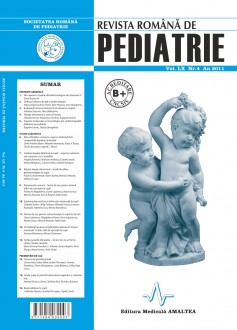SELECT ISSUE

Indexed

| |

|
|
|
| |
|
|
|

|
|
|
|
|
|
|
HIGHLIGHTS
National Awards “Science and Research”
NEW! RJP has announced the annually National Award for "Science and Research" for the best scientific articles published throughout the year in the official journal.
Read the Recommendations for the Conduct, Reporting, Editing, and Publication of Scholarly work in Medical Journals.
The published medical research literature is a global public good. Medical journal editors have a social responsibility to promote global health by publishing, whenever possible, research that furthers health worldwide.
Chronic rhinosinusitis as a risk factor of difficult to control asthma. Therapeutical considerations
Magdalena M. Florea, Oana Lăzărescu, Ileana Ioniuc, Monica Alexoae, Aurica Rugina and Stela Gotia
ABSTRACT
Children with difficult to control asthma are a heterogeneous group. These cases need a review of diagnosis and evaluation of the different risk factors for loose control. There are known that nasal sinus disease may contribute to less control of asthma. The prevalence of chronic rhinosinusitis in the pediatric population is inversely related to the age of the patient. Many features of CRS are similar with those of viral upper respiratory tract infections or allergic rhinitis. That is why the diagnosis of CRS in this group can be more difficult to make. The effect on quality of life for chronic rhinosinusitis (CRS) in the pediatric population is also significant. Our study wants to prove that antibiotic treatment with antihistamines associated to combine asthma therapy in asthmatic children with chronic sinus disease may improve quality of life and lung function.
Methods: 31 children (ages between 8-18), with mild to severe persistent asthma and chronic rhinosinusitis were tested using tests of quality of life (Juniper 2001), ENT exam, sinus X-ray, eosinophyls and microbiological examination in sputum and nasal secretions, spirometry (Pony FX) before and after 3 month of combined anti-inflammatory and long acting beta agonist (GINA 2006) therapy, associated with a broad-spectrum antibiotic, nasal steroid and an oral antihistamine.
Results: after 3 month of combined therapy, quality testing of life was significantly improved, from symptomatic (p=0,024), activity (p=0,003) and emotional (p<0,001) point of view, as well as FEV1 (p<0,001), but has not MEF50 (p=0,105, p>0,05).The positive evolution was found in 28/31 cases. The pattern of inflammation in the airways was eosinophilic (3/21 cases tested), neutrophilic (13/21 cases tested), mixed (3/21 cases tested) and non-inflammatory (2/21 cases tested). The most common microbian agents found in sputum culture was Haemophylus influentzae (6/22 cases tested), Streptococcus pneumoniae (4/22 cases tested), Branhamella catharalis (7/22 cases tested).
Conclusions: the treatment of chronic rhinosinusitis (specific antibiotherapy, antihistamines) associated with aggressive treatment against eosinophylic inflammation of airways improve the quality of life and lung function of those children with difficult to control asthma.
Key words: chronic rhinosinusities, asthma, complex treatment, quality of life tests, pulmonary function
